
China, officially the People's Republic of China (PRC), has full diplomatic relations with 180 out of the other 192 United Nations member states, Cook Islands, Niue and the State of Palestine. As of 2024, China has had the most diplomatic missions of any state.
Geopolitics is the study of the effects of Earth's geography on politics and international relations. While geopolitics usually refers to countries and relations between them, it may also focus on two other kinds of states: de facto independent states with limited international recognition and relations between sub-national geopolitical entities, such as the federated states that make up a federation, confederation, or a quasi-federal system.
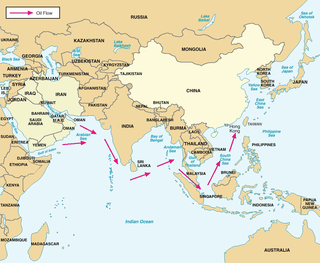
Sea lines of communication is a term describing the primary maritime routes between ports, used for trade, logistics and naval forces. It is generally used in reference to naval operations to ensure that SLOCs are open, or in times of war, to close them. The importance of SLOCs in geopolitics was described in Nicholas J. Spykman's America's Strategy in World Politics published in 1942.
Geostrategy, a subfield of geopolitics, is a type of foreign policy guided principally by geographical factors as they inform, constrain, or affect political and military planning. As with all strategies, geostrategy is concerned with matching means to ends Strategy is as intertwined with geography as geography is with nationhood, or as Colin S. Gray and Geoffrey Sloan state it, "[geography is] the mother of strategy."

Nicholas John Spykman was an American political scientist who was Professor of International Relations at Yale University from 1928 until his death in 1943. He was one of the founders of the classical realist school in American foreign policy, transmitting Eastern European political thought to the United States.

The Rimland is a concept championed in the early 20th century by Nicholas John Spykman, professor of international relations at Yale University. To him, geopolitics is the planning of the security policy of a country in terms of its geographical factors. He described the maritime fringe of a country or continent; in particular the densely populated western, southern, and eastern edges of the Eurasian continent.

"The Geographical Pivot of History" is an article submitted by Halford John Mackinder in 1904 to the Royal Geographical Society that advances his heartland theory. In this article, Mackinder extended the scope of geopolitical analysis to encompass the entire globe. He defined Afro-Eurasia as the "world island" and its "heartland" as the area east of the Volga, south of the Arctic, west of the Yangtze, and north of the Himalayas. Due to its strategic location and natural resources, Mackinder argued that whoever controlled the "heartland" could control the world.

The United States foreign policy toward the People's Republic of China originated during the Cold War. At that time, the U.S. had a containment policy against communist states. The leaked Pentagon Papers indicated the efforts by the U.S. to contain China through military actions undertaken in the Vietnam War. The containment policy centered around an island chain strategy. President Richard Nixon's China rapprochement signaled a shift in focus to gain leverage in containing the Soviet Union. Formal diplomatic ties between the U.S. and China were established in 1979, and with normalized trade relations since 2000, the U.S. and China have been linked by closer economic ties and more cordial relations. In his first term as U.S. president, Barack Obama said, "We want China to succeed and prosper. It's good for the United States if China continues on the path of development that it's on".

East Asia is a region of Asia, which is defined in both geographical and ethno-cultural terms. The modern states of East Asia include China, Japan, Mongolia, North Korea, South Korea, and Taiwan. Hong Kong and Macau, two coastal cities located in the south of China, are autonomous regions under Chinese sovereignty. The economies of Japan, South Korea, China, Taiwan, Hong Kong, and Macau are some of the world's largest and most prosperous economies. East Asia borders Siberia and the Russian Far East to the north, Southeast Asia to the south, South Asia to the southwest, and Central Asia to the west. To the east is the Pacific Ocean and to the southeast is Micronesia.
The String of Pearls is a geopolitical hypothesis proposed by United States political researchers in 2004. The term refers to the network of Chinese military and commercial facilities and relationships along its sea lines of communication, which extend from the Chinese mainland to Port Sudan in the Horn of Africa. The sea lines run through several major maritime choke points such as the Strait of Mandeb, the Strait of Malacca, the Strait of Hormuz, and the Lombok Strait as well as other strategic maritime centres in Somalia and the littoral South Asian countries of Pakistan, Sri Lanka, Bangladesh, and the Maldives.
U.S. President Barack Obama's East Asia Strategy (2009–2017), also known as the Pivot to Asia, represented a significant shift in the foreign policy of the United States since the 2010s. It shifted the country's focus away from the Middle Eastern and European sphere and allowed it to invest heavily and build relationships in East Asian and Southeast Asian countries, especially countries which are in close proximity to the People's Republic of China (PRC) either economically, geographically or politically to counter its rise as a rival superpower.

The Senkaku Islands dispute, or Diaoyu Islands dispute, is a territorial dispute over a group of uninhabited islands known as the Senkaku Islands in Japan, the Diaoyu Islands in China, and Tiaoyutai Islands in Taiwan. Aside from a 1945 to 1972 period of administration by the United States as part of the Ryukyu Islands, the archipelago has been controlled by Japan since 1895. The territory is close to key shipping lanes and rich fishing grounds, and there may be oil reserves in the area.
AirSea Battle is an integrated battle doctrine that forms a key component of the military strategy of the United States. The doctrine became official in February 2010, and was renamed to Joint Concept for Access and Maneuver in the Global Commons (JAM-GC) in 2015.
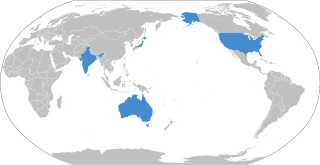
The Quadrilateral Security Dialogue (QSD), commonly known as the Quad, is a strategic security dialogue between Australia, India, Japan and the United States that is maintained by talks between member countries. The dialogue was initiated in 2007 by Japanese Prime Minister Shinzo Abe, with the support of Australian Prime Minister John Howard, Indian Prime Minister Manmohan Singh and U.S. Vice President Dick Cheney. The dialogue was paralleled by joint military exercises of an unprecedented scale, titled Exercise Malabar. The diplomatic and military arrangement was widely viewed as a response to increased Chinese economic and military power.
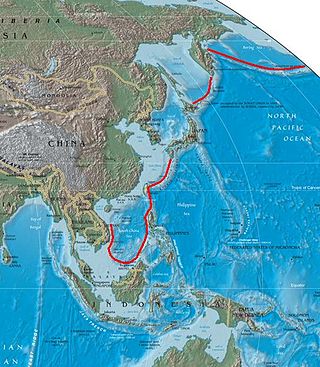
The first island chain refers to the first chain of major Pacific archipelagos out from the East Asian continental mainland coast. It is principally composed of the Kuril Islands, the Japanese archipelago, the Ryukyu Islands, Taiwan (Formosa), the northern Philippines, and Borneo, hence extending all the way from the Kamchatka Peninsula in the northeast to the Malay Peninsula in the southwest. The first island chain forms one of three island chain doctrines within the island chain strategy in the U.S. foreign policy.
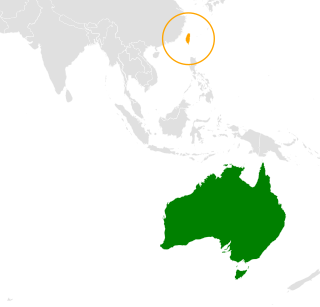
Relations between the Commonwealth of Australia and the Republic of China, formerly the Qing dynasty, date back to 1909. Since 1972, the political status and legal status of Taiwan have been contentious issues. Australia and Taiwan share partnership in the inter-governmental Global Cooperation and Training Framework (GCTF) activities.
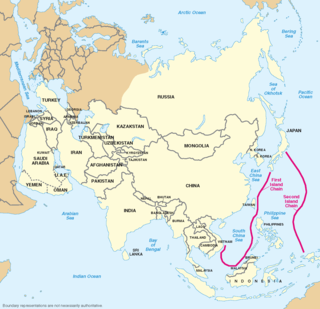
The island chain strategy is a strategic maritime containment plan first conceived by American foreign policy statesman John Foster Dulles in 1951, during the Korean War. It proposed surrounding the Soviet Union and China with naval bases in the West Pacific to project power and restrict sea access.

Chinese irredentism involves irredentist claims to the territories of former Chinese dynasties made by the Republic of China (ROC) and subsequently the People's Republic of China (PRC).

Free and Open Indo-Pacific is an umbrella term that encompasses Indo-Pacific-specific strategies of countries with similar interests in the region. The concept, with its origins in Weimar German geopolitics, has been revived since 2006 through Japanese initiatives and American cooperation.
The Clean Network was a U.S. government-led, bi-partisan effort announced by then U.S. Secretary of State Mike Pompeo in August 2020 to address what it describes as "the long-term threat to data privacy, security, human rights and principled collaboration posed to the free world from authoritarian malign actors." Its promoters state that it has resulted in an "alliance of democracies and companies," "based on democratic values." According to the Trump administration, the Clean Network is intended to implement internationally accepted digital trust standards across a coalition of trusted partners.













